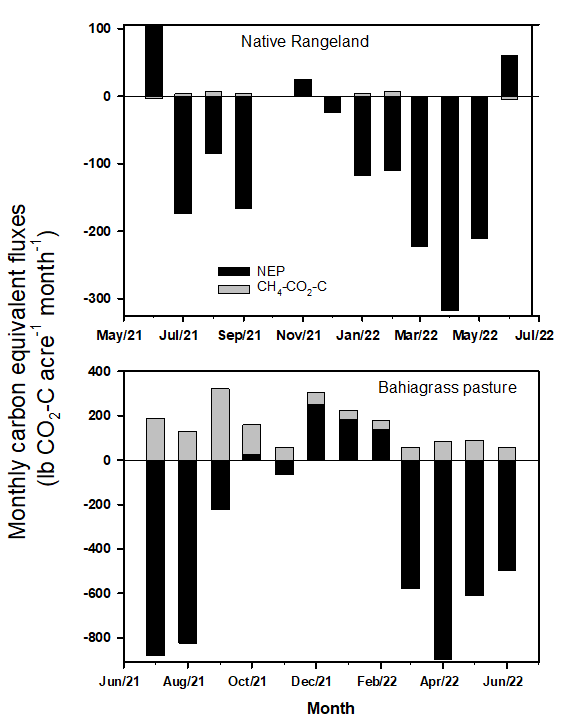- Return to Article Of The Month index
Perrenial Pasture Systems in Florida are Strong Carbon Sinks
October, 2022
Rosvel Bracho, Research Assistant, UF School of Forest Fisheries and
Geomatics Sciences, and
Maria L. Silveira,
Professor, UF Range Cattle Research & Education Center
Part of this article was previously published
in the Florida Cattleman and Livestock Journal. It provides information
about a project led by Drs. Bracho and Silveira that was designed to
evaluate ecosystem carbon balance (difference between the amount of carbon
fixed through photosynthesis and carbon losses by respiration) and global
warming potential associated with typical pasture-based cow calf production
systems in Florida.
More than half of the
agricultural lands in Florida are used for cattle production, providing food
to millions and many other societal benefits. Among the important ecosystem
services that pastures provide, carbon sequestration and climate regulation
are perhaps one of the most underrated, particularly by society at large.
Pasture soils are one of the most significant reservoirs of soil organic
carbon, accounting for approximately 30% of total global soil organic
carbon. Soil carbon sequestration provides a long-term alternative to
mitigate greenhouse gas emissions and to adapt to the adverse impacts of
global climate change. However, the magnitude of carbon sequestration in
pastures depends on management. Current pasture management strategies (e.g.,
fertilization strategy and grazing management) are generally aimed at
increasing forage and animal production but they can also have positive
impacts on carbon sequestration.
Some of the key parameters either measured or
estimated at each study site included Net Ecosystem Productivity (NEP),
methane emissions, and global warming potential. NEP is the difference
between gross primary production and total ecosystem respiration. It
represents the rate of carbon accumulation in the system with negative NEP
values indicating a net gain (“sink”) of carbon. Methane emissions included
both soil and animal emissions; values were converted into carbon dioxide
equivalents (CO2eqv) in a 100 year scenario. Global warming
potential is a metric to compare the ability of different greenhouse gases
(carbon dioxide, nitrous oxide and methane) to trap heat in the atmosphere.
Greenhouse gases differ in their ability to absorb energy and in their
atmospheric residence times. Each gas has a specific global warming
potential, which allows comparisons of the amount of energy the emissions of
1 ton of a gas will absorb over a given time period, usually a 100-year
averaging time, compared with the emissions of 1 ton of CO2.

1Warming potential =
Warming Potential in 100 years scenario (IPCC, 2014).
2Negative values
indicate C sink capacity while positive values indicate C source.
These results suggest that both cow-calf production systems are viable options for carbon mitigation while also providing many other ecosystem services such as food, biodiversity, and water protection among many others. Climatic variability is very strong in Florida, with common occurrence of extreme weather events such as droughts, tropical storms, and hurricanes. Thus, multi-year research is necessary to confirm and validate the data as well as to fully understand the impacts of climate and management on carbon fluxes in Florida pastures.
Acknowledgements. We thank the Florida Cattle Enhancement Board for providing funds to support this project. We also thank the support from the Long-Term Agroecosystem Research (LTAR) network and the UF/IFAS Range Cattle Research and Education for providing the resources and instrumentation to conduct the project.
References
Intergovernmental Panel on Climate Change (IPCC) 2014. Climate Change 2014:
Synthesis Report. Contribution of Working Groups I, II and III to the Fifth
Assessment Report of the Intergovernmental Panel on Climate Change.
Intergovernmental Panel on Climate Change, Geneva, Switzerland.
| a. | b. | c. |
 |
 |
 |
Figure 1. Eddy covariance
towers (a and b) and chamber-based (c) measurements of greenhouse gas
emissions from bahiagrass pastures and native rangelands


